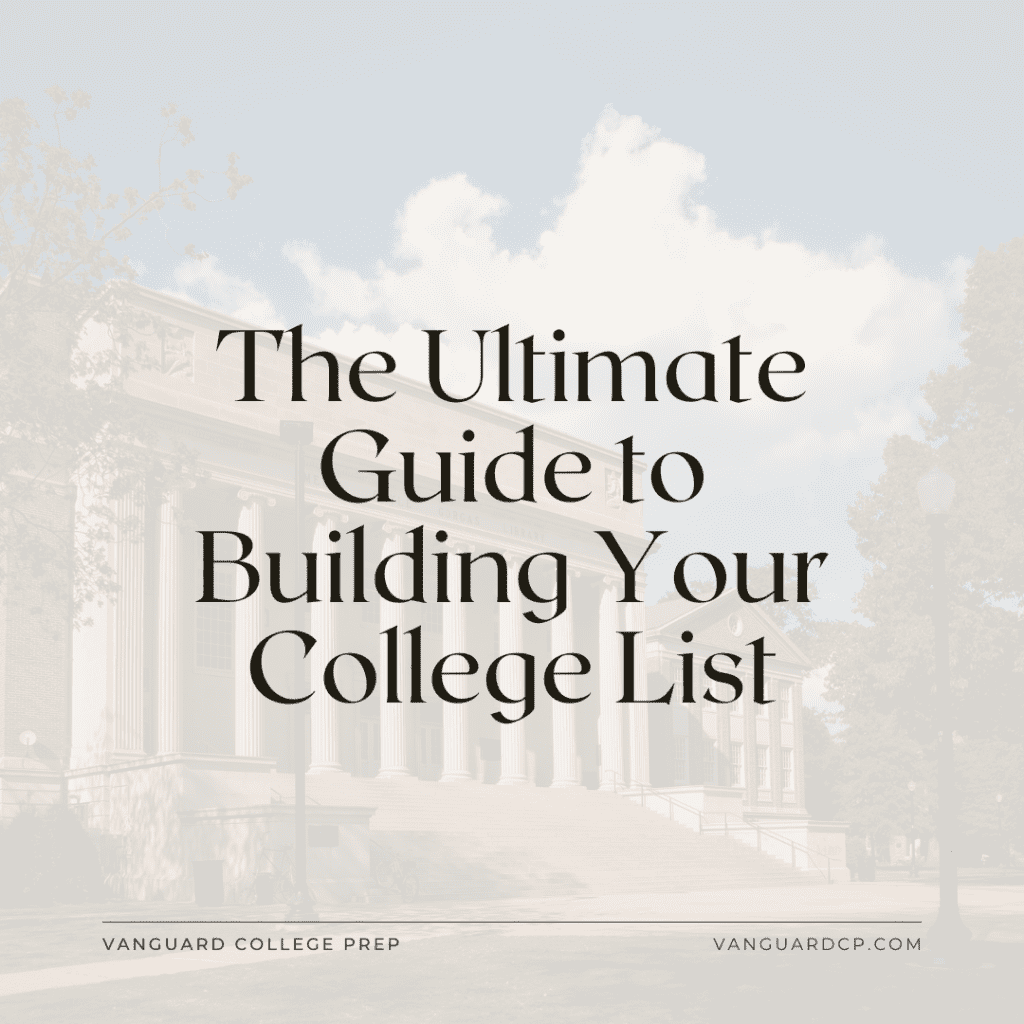- Leave a Comment
- May 25 2023
- College Applications
- By vanguard
The Ultimate Guide to Building Your College List
Spring of Junior Year is the ideal time to start building a list of colleges you plan to apply to in the fall. By February, you should have a shortlist of 15-20 schools that have caught your eye, so you can spend the rest of the semester taking notes, planning college visits, and scrolling on TikTok (yes, you read that right– check out our post on how to utilize social media in the college research and supplemental essay-writing processes).
Following this timeline, by the end of Junior year you should be pretty certain about which schools you plan to apply to, and with THAT massive hurdle out of the way, you’ll have all summer to perfect your essays and round out your resume with impressive extracurriculars.
But how should you choose which schools to apply to? And what other decisions will you need to make along the way? Let’s start with the most obvious question:
- Where are you applying?
Where indeed? Does geographic location matter to you? Do you want to be within a 1-hour drive of your hometown, or do you want to put as much distance between your college and your high school as possible? Do you love the sea? Hate snow? Are you looking for a cozy, close-knit campus community where professors know all their students by name, a mid-sized college town with lots of student-friendly hangout spots, or a booming metropolis where the campus is almost indistinguishable from the busy urban landscape?
Once you’ve figured out which of those categories you’re learning toward, you’ll want to start thinking about which schools can provide you the best professional development opportunities through internships, research, and career opportunities that align with your interests. Check out colleges’ Career Center webpages for a sneak peek into what kind of career support they offer their students.
College isn’t all about professional development, though. The colleges you apply to should also provide a comfortable atmosphere and sense of community that will help you thrive during your time there. Remember, this place will be home for at least 4 years! Do you like the food served in the dining hall, or will you be eating vending machine dinners 4 nights a week? Are the dorms cozy and community-oriented or crowded and crumbling? Will you have a safe and convenient way to travel around and off campus? Are there student organizations on campus who share interests or hobbies with you? Often the best way to answer these questions is by registering for in-person campus visits or virtual info sessions. We also love to connect our current Vanguard students with Vanguard alum at colleges around the country!
Once you’ve compiled some detailed notes on the schools you’re researching, you’ll need to start organizing them into Safety, Match, and Reach categories. There’s no clear-cut criteria for which schools fit into which category, but it typically corresponds with the school’s acceptance rate. Acceptance rates can vary within a school depending on whether or not you’re applying to a competitive major, and students with stronger profiles (higher test scores, more robust resumes, better essays, more rigorous transcripts, etc.) will have more wiggle room to work with. Here’s a very general breakdown of how most students should categorize their college list:
Safety: 75-100%+ acceptance rate,
Match: 40 - 75% acceptance rate
Reach: 20 - 40% acceptance rate
Super Reach: 1 - 20% acceptance rate
The main takeaway here? Don’t make too many gambles. If you plan to apply to 9 schools, don’t apply to 7 Reaches, a Match, and a Safety. Keep your list well-balanced, so you have lots of options to choose from when the decision letters start rolling in.
Note: A school’s acceptance rate is often equated with its quality or value – the lower the percentage, the higher a school is ranked. But this leaves one very important factor out of the equation: you! Just because a school has a 10% acceptance rate, and just because they sent you an acceptance letter, that doesn’t necessarily mean it’s the school where you’ll be happiest or most successful. When building your College List, be careful not to let college ranking lists weigh too heavily in your future-planning.
- Which majors are you applying to study?
There’s no simple formula for determining this one either, I’m afraid. When one of my students is on the fence about major choice, I usually advise them to start by taking a nice long look at their resume. What are the recurring themes or common threads that run throughout all 4 years of their high school experience? Which majors best align with their professional skills and personal interests?
Once you’ve narrowed it down to a few choices, dig a little deeper. Curriculum requirements and concentrations for the exact same major can vary widely from one college to the next. The Computer Science major at one school may place a heavy emphasis on Machine Learning and AI, while at another school it may be more Game Development-focused. Take a good look at the required courses for the majors you’re considering at the schools where you plan to apply to that major program. If you really want to be in the know, read the course descriptions in the course catalog, and check out what kind of research is being conducted by professors and students within the department.
Once you’ve done your homework, you’ll need to choose a first choice major and a second choice major for most college applications. The first choice major should typically be – well – your first choice! This should be the major you would most like to study at that particular college. The second choice major (not to be confused with a double-major or a minor, which can be added on to your degree plan after starting classes) should be your backup plan. If a college doesn’t grant you a spot within your first-choice major program, what’s your Plan B?
Note: If you’re applying for a competitive major (meaning it’s extremely popular and in high demand at the college you’re applying to, or it has a very high academic standard), be sure your second choice major is less risky. At most colleges and in most majors (there are a few exceptions), you can switch your major after the first semester or two, so don’t sweat it too much if you’re not immediately admitted into your first choice!
- Which deadline are you applying by?
Most schools have deadlines that fall sometime between November 1 and January 1st, but there are plenty of exceptions. Watch out for scholarship deadlines, which some schools implement as a cutoff date for institutional scholarship eligibility. And if you’re thinking of applying Early Decision somewhere, be sure you know what you’re signing up for!
It’s a lot to navigate, there’s no doubt about it. Starting on your college list in the spring of Junior year will set you up for a productive and meaningful summer as you draw nearer and nearer to the main event: college application season! Follow along here at our blog, on Social Media, and on YouTube, to learn more tips and insights on the college application process– and click here to learn more about our full range of Test Prep, College Counseling, and Essay Specialist services.



Leave Your Comment